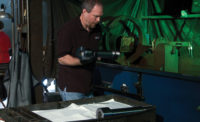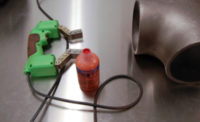Magnetic Particle Testing 101: A Tutorial
Current codes, specifications and contracts usually require MT personnel to be certified.

Fusion line crack detected with black particles and white contrast paint. Source: Quality Testing Services Inc.
It is true that magnetic particle testing (MT) is one of the oldest NDT methods, and over the years has proven itself to be not only reliable, but cost effective, when it is applied properly with qualified personnel. Earlier articles published in Quality, “Key Elements of Magnetic Particle Testing” and “Magnetic Particle Testing Issues,” covered basic elements, techniques, variables, procedures and evaluation. It is the purpose of this article to point out the problems that can result when MT is not done correctly. One of the subtle pitfalls occurs when the practitioner becomes lackadaisical due to repeated use over the course of an extended period. It is true that MT is not one of the most exciting and challenging NDT methods, and in many cases, it can be extremely routine and repetitious. Simply put, it’s hard work. It takes concentration and dexterity. The equipment can be heavy, and the work environment may be dirty or noisy. In many instances, MT personnel are not given the respect and recognition they deserve. And yet, they are required to be qualified in the technology and pass examinations for certification.
Qualified Personnel: The Key to Successful MT
Current codes, specifications and contracts usually require MT personnel to be certified. And while certification is important and provides for a level of recognition, it is far more important that the personnel be qualified. It is well known that qualification is a blend of training and experience.
Training
An effective training program for MT personnel should cover at least the following:
- A basic understanding of materials: those that can and cannot be examined, and how they respond to magnetic fields.
- Materials processes and related discontinuities: how they’re formed and appearance.
- Principles of magnetism: an understanding of its characteristics and how materials are magnetized by applied electrical current (direct) or by induction (indirect).
- MT techniques and variables: continuous/residual, visible/fluorescent.
- Equipment and accessories: stationary/portable.
- Procedures: acceptance criteria, and records.
- Types of identification of discontinuities to be encountered by MT.
- Safety considerations: hazards and materials control.
- Hands-on practical laboratory sessions: planned, controlled sessions using actual equipment and test specimens representative of applications to be encountered.
- Periodic course quizzes and course completion examination.
- Self-study and reading assignments.
Experience
SNT-TC-1A (2016 Edition) defines experience as:
“Work activities accomplished in a specific NDT method under the direction of qualified supervision including the performance of the NDT method and related activities but not including time spent in organized training programs.”
NAS 410 (Rev. 4) defines experience as:
“Actual performance of an NDT method conducted in the work environment resulting in the acquisition of knowledge and skill. This does not include formal classroom training, but may include laboratory and on-the-job training as defined by the employer’s written practice.”
Magnetic Particle Codes and Standards (Partial Listing)
ISO 9934-1, Non-destructive testing — Magnetic particle testing — Part 1: General principles.
ISO 9934-2, Non-destructive testing — Magnetic particle testing — Part 2: Detection media
ISO 9934-3, Non-destructive testing — Magnetic particle testing — Part 3: Equipment
ISO 6933, Railway rolling stock material — Magnetic particle acceptance testing
ISO 4986, Steel castings — Magnetic particle inspection.
ISO 13664, Seamless and welded steel tubes for pressure purposes — Magnetic particle inspection of the tube ends for the detection of laminar imperfections.
ISO 13665, Seamless and welded steel tubes for pressure purposes — Magnetic particle inspection of the tube body for the detection of surface imperfections.
BS EN ISO 9934-1:2016 Non-destructive testing. Magnetic particle testing. General principles
ISO 17638:2016(en) Non-destructive testing of welds — Magnetic particle testing
ASTM E709 2015 Edition, June 1, 2015 Standard Guide for Magnetic Particle Testing
ASTM E1444/E1444M 2016 Edition, June 1, 2016 Standard Practice for Magnetic Particle Testing
ASTM E3024/E3024M 2016 Edition, July 1, 2016 Standard Practice for Magnetic Particle Testing for General Industry
ASTM A275/A275M 2015 Edition, May 1, 2015 Standard Practice for Magnetic Particle Examination of Steel Forgings
ASTM A966 / A966M - 15 Standard Practice for Magnetic Particle Testing
ASTM A456/A456M 8th Edition, 2013
Standard Specification for Magnetic Particle Examination of Large Crankshaft Forgings
AWS D1.1: Structural Welding Code - Steel
AWS D1.2: Structural Welding Code Aluminum
AWS D1.3: Structural Welding Code
- Sheet Steel
AWS D1.5: Bridge Welding Code
ASME Section V, Article 7
So, what is experience? It has been a practice with widespread inconsistencies even though the definitions above appear to provide guidance on the subject of experience. Here are some recommendations as to how meaningful experience can be achieved:
- Consider the word “qualified” in the SNT-TC 1A definition. What is meant by “qualified supervision”? Ideally the individual overseeing the experience should be at least a certified Level II in the method being observed.
- The experience should be accomplished using the applicable procedures and equipment to be used on the materials and parts during actual inspections.
- The time gaining the experience should be logged and validated by the overseer by dates and hours.
- In addition to documenting time, the techniques and parts examined should also be noted. This will be useful for future certification consideration.
- It would be well to have a checklist prepared with key elements of the experience. It will provide a degree of assurance that the experience being achieved covers the range of applications to be encountered in actual inspections.
- Assure that the experience includes the care, maintenance and storage of the equipment and accessories.
The Procedure
A detailed and qualified procedure is essential for performing an effective and compliant magnetic particle inspection. It is best prepared by a certified and qualified individual with Level III certifications in MT. Once the procedure is finalized, it should be qualified. Some codes require this but if not, it is strongly recommended. Procedure qualification includes actual performance by a qualified MT inspector using controlled test specimens. It should be observed by a Level III individual, and it may be appropriate (or even required) to have a client representative present for the process. When the procedure qualification is satisfactorily completed, it should be documented and include the name(s) of the observers. The procedure should include, as a minimum, the following:
Cover sheet with name of preparer, Level III approval, effective date.
- Scope
- Applicable reference documents.
- Personnel qualifications/certifications.
- Equipment and accessories description.
- Surface preparation.
- Techniques to be used.
- Detailed steps in the inspection process.
- Evaluation if indications.
- Preparation of inspection report.
- Cleaning and demagnetization.
- Application of surface protective material if necessary.
The evaluation of indications requires a high level of skill. There has been some confusion regarding the difference between indications, discontinuities, and defects.
The term “indication” is defined as a response or evidence of a response disclosed through a nondestructive test that requires further evaluation to determine its full significance. When a particle buildup occurs on the test surface during an MT inspection, it is should be referred to as an “indication.” Indications should then be evaluated and classified into one of three groups: false, nonrelevant, discontinuities (relevant), and defects.
False Indication
A false indication is the presence of particles on the surface that is not held by a magnetic leakage field. The particles are held by gravity or some type of contaminant on the test surface. To confirm that it is “false,” the indication should be removed, and the surface reexamined after addressing the reason for the particle accumulation. False indications will not reappear once corrective steps have been taken. So, one can say that a false indication is not predictable and not repeatable.
Nonrelevant Indication
A nonrelevant indication is one that’s due to magnetic flux leakage from conditions other than actual discontinuities. Many times, it is the result of the design or configuration of the test object. This may be the result of constriction that can be caused by sharp corners or abrupt changes is the geometry of the test object. Other nonrelevant indications may be caused by changes in permeability within the test object. A forging with smooth machined or ground surfaces may reveal a “flow line” pattern due to grain alignment. In some materials, a change in permeability may occur at the fusion line in a weld and the resultant linear indication may incorrectly be evaluated as a crack or lack of fusion. Hard spots on the test surface may also cause a nonrelevant indication.

A seam in a threaded bar detected with fluorescent particles. Source: Quality Testing Services Inc.
Discontinuity (relevant) Indications
Relevant indications are caused by actual discontinuities. They are defined as flaws, imperfections or other conditions that are not part of the normal structure of the test object. There are many different types of discontinuities that can be classified as inherent (formed during the original making of the material), primary processing (caused during a rough shaping process; forging, casting, etc.), secondary processing (occurring during the finishing steps; machining, surface grinding, heat treating, etc.), service (after the part is put into service – fatigue cracks, corrosion, erosion, etc.), and those that occur during the welding process (porosity, cracks, lack of fusion/penetration, inclusions, etc.). MT is most responsive to those discontinuities that are generally linear and at or very close to the surface. Rounded discontinuities such as porosity cannot always be detected since their shape does not always provide flux leakage. Typically, the flux lines tend to flow around the pores rather that break at the pore.
Defects
There are many definitions of the term “defect.” It is generally considered to mean a defective condition where it applies to nondestructive testing. This is a condition that would render the object or material being examined to not be usable in its present state. There is also a definition that implies that a defect is one that does not meet the acceptance criteria of a code, standard, or specification. The former definition is the most applicable. Therefore, indications of discontinuities should be evaluated as acceptable or rejectable in accordance with the applicable acceptance criteria. All discontinuities evaluated as rejectable will not necessarily render the part not usable. Porosity for example, are not usually considered severe stress risers and may never cause the part to be “not usable.”
Misunderstandings
It is a general belief that the use of alternating current (as with an AC yoke), will only detect discontinuities that are at the surface of the test object. It has been proven that slightly subsurface discontinuities can also be detected if they are linear and the orientation is favorable. On the other hand, there are those who believe deeply subsurface discontinuities can be detected with direct current. There are many variables that must be considered when considering the depth a discontinuity can be detected, including the permeability of the material, the orientation of the discontinuity, the current applied, type of particles (dry or wet suspension) and surface condition. Considering these variables, it is most logical to consider that MT is best for surface, and under ideal conditions, slightly subsurface discontinuities.
Is it possible to determine if a discontinuity is at the surface or slightly subsurface? The most effective way is to remove the particle buildup and just reapply the particles. There is usually a strong enough residual field to hold the particle if the discontinuity is at the surface. The leakage field with a slightly subsurface discontinuity is usually not adequate to hold particles.
The residual technique is quite effective for detecting surface discontinuities but not for those that are subsurface.
Looking for a reprint of this article?
From high-res PDFs to custom plaques, order your copy today!









